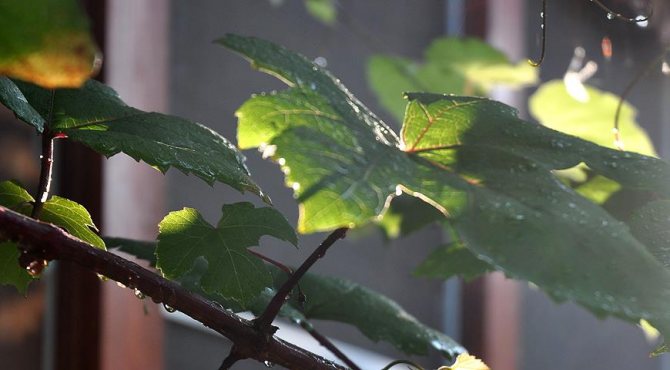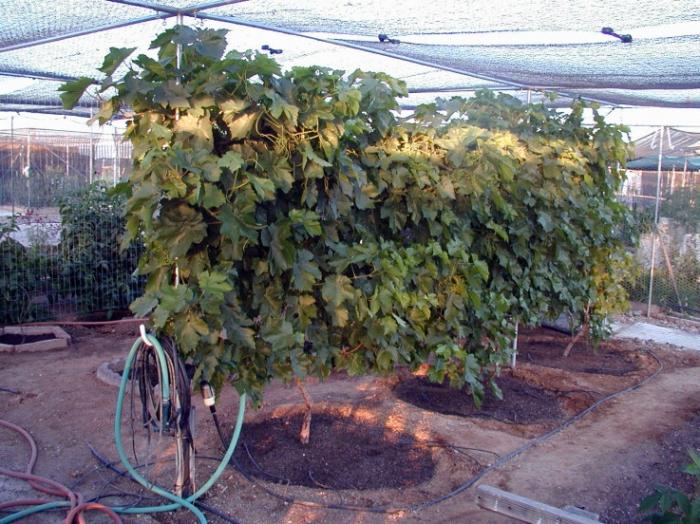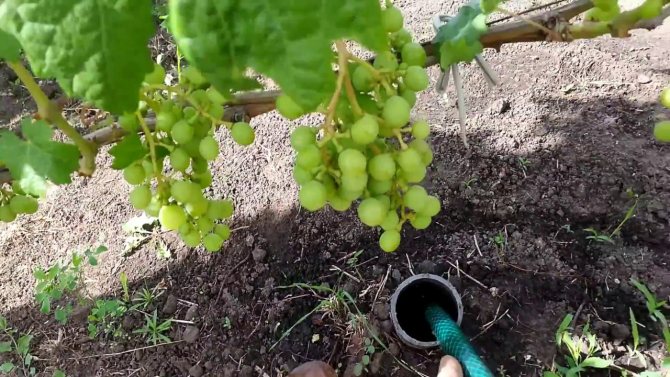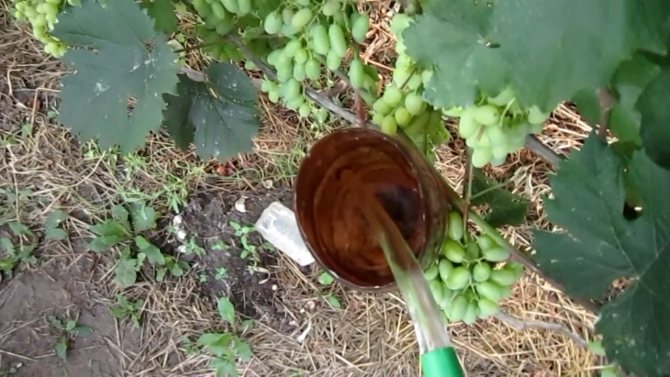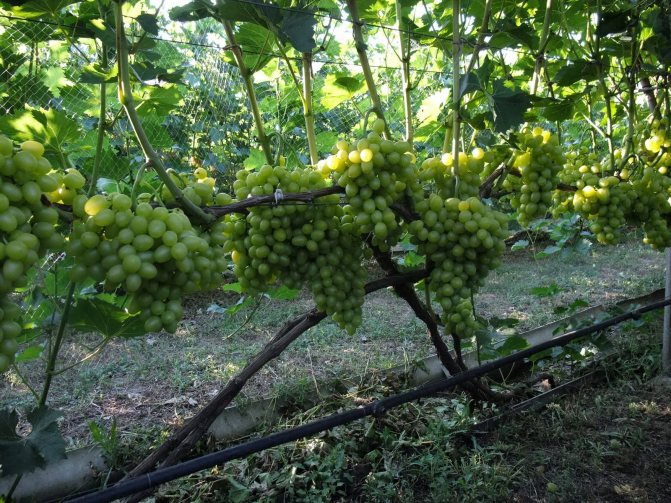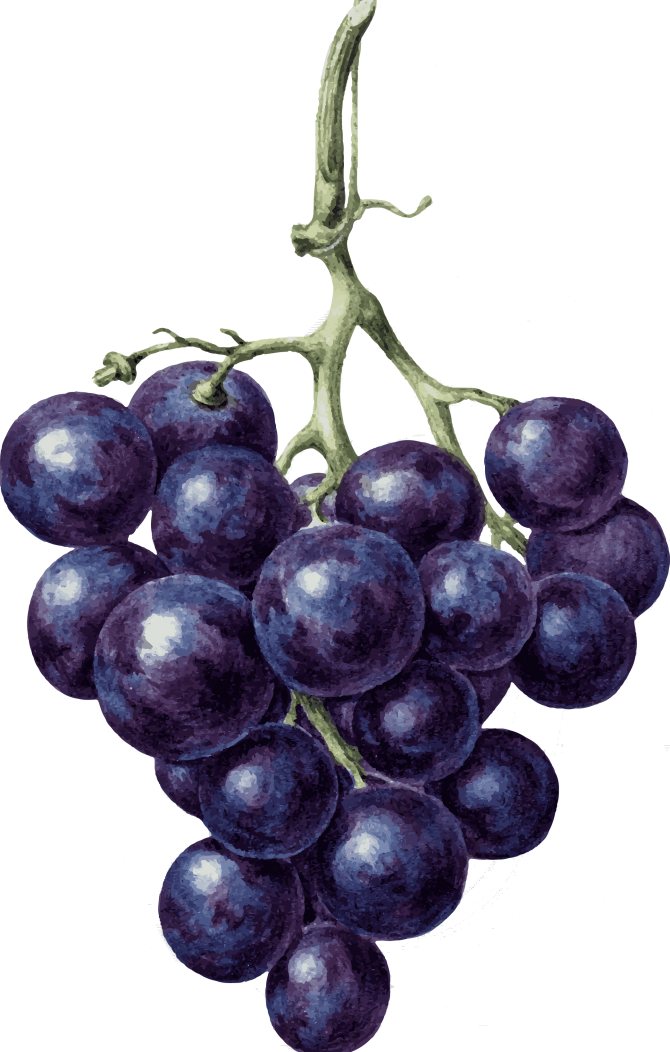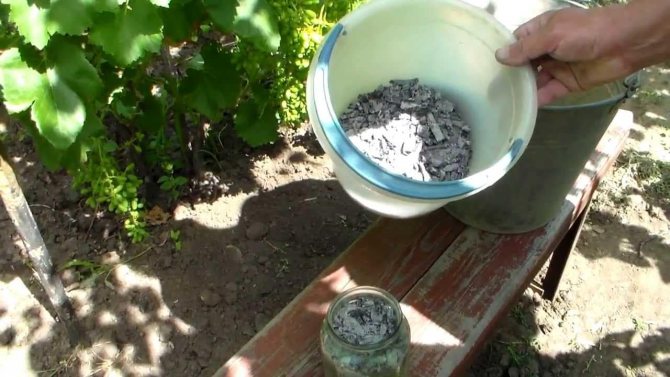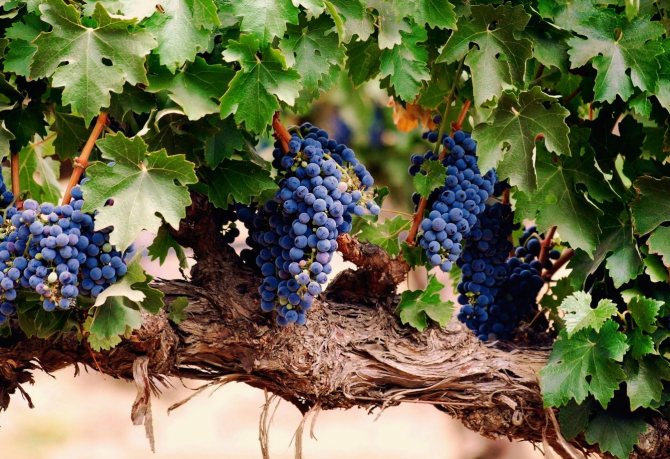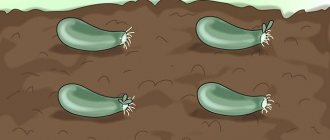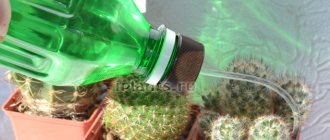- Types of watering grapes Autumn water charging grapes
- Spring water charging grapes
- Planting watering of grapes
- Vegetative watering of grapes
Watering errors
A large number of novice gardeners make a significant number of mistakes when irrigating plants, which can negatively affect flowering and fruiting not only in a particular season, but also in subsequent years. This aspect must be taken into account in order to preserve the grapes. How often is watering needed? You can determine this parameter after reading the common mistakes of novice gardeners:
- Watering with a hose from the water supply system on top is carried out every day or every other day, and is also combined with the care of other seedlings or flowers.
- Irrigation takes place directly from the wells.
Such methods of watering do not bring good to the grapes, but only significant harm that impedes growth and development. It is necessary to know the classification of irrigation and understand their meaning in order to carry out this procedure in accordance with all the rules.
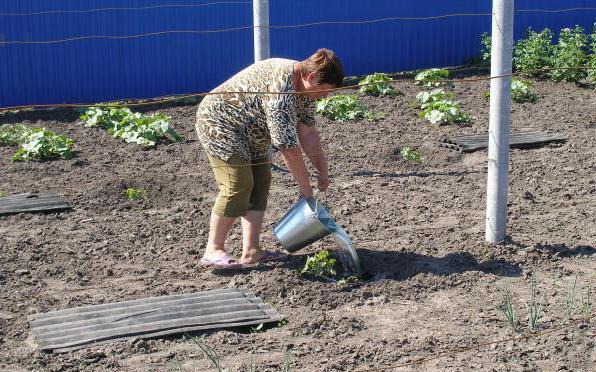
conclusions
Irrigation is one of the most difficult agricultural procedures. Lack can destroy, as well as excess. It has a strong root system, which is why above-soil irrigation is used only in autumn. Rules:
- Norms depend on the weather, season and soil conditions.
- Distinguish between superficial, subsoil, sprinkler and drip species.
- Watering is efficiently combined with fertigation, that is, the simultaneous application of fertilizers.
- Determine the flaw is possible by the appearance of the soil and bush. More accurate measurements are made with a tonsiometer.
- Vineyards use these methods subsoil irrigation: drip, using a blind tube, pits or through special checks.
- The main mistakes when watering: using cold water, watering the vines during flowering and before setting the bunches. It is also wrong to water the grapes superficially, but often and little by little.
Too much water is just as bad as not being enough. This leads to a heavier earth, oxygen starvation of the bushes.
Autumn watering
If there is a question as to how to water the grapes, it should be remembered that the liquid is directed along the trenches and holes for wells. This watering is one of the most important steps in filling the earth with water. It should be done especially carefully in dry autumn. The ground should not be allowed to be dry when cold weather sets in. If you don't add the right amount of water, the cold can penetrate deep into the soil. This happens because the soil becomes loose, additional holes and pores are formed that can harm the roots of the plant. Cold air freely enters the formed cracks, which leads to complete or partial damage to the entire root system.


Water-charging autumn irrigation is designed to saturate the soil with water until the next growing season.It should be remembered that if water is poured into the bush, then even with a plentiful and strong stream, it will be able to penetrate no further than 30-40 cm deep, which helps to preserve the grapes. Watering in the fall will ensure that the moisture sinks slowly enough. It takes about a month for the liquid to move 20 cm. When summer comes, the water is at a depth not exceeding 1.5 m. This depth is a mark at which the soil does not dry out even in the driest years. Grapes, which are less watered in summer, grow better as they do not harm the plant.
The essence of the method
The grape is distinguished by highly branched roots. The roots of the grapes usually go up to 14 m in the ground and yet have a diameter of about 2.5 m. This is much larger than the diameter of the usual hole, which is used for surface irrigation. It is also worth noting that the main consumers of moisture in grapes are the heel roots, which are located at a distance of at least 0.5 m below the ground. This means that moisture often simply does not reach the heel roots. This problem is especially acute if the plant grows on heavy loamy soil. In this case, it is better to supply water directly to the roots using drainage irrigation.
The main advantages and disadvantages of drainage irrigation
Among the main advantages that underground irrigation is endowed with are:
- the ability to supply liquid directly to the roots of the grapes through a tube, which is very effective;
- significant water savings, which is explained by the impossibility of moisture evaporation;
- reducing the likelihood of developing fungal diseases of the plant, since moisture does not get on the ground part of the plant, as with other methods of irrigation.
- prevention of soil salinization, since water does not enter the upper part of the earth;
- the ability to deliver fertilizers directly to the roots.
The disadvantages of this method include high labor costs for arranging the system. In addition, underground watering is much more troublesome, because in this case, water must be carried in buckets under all the bushes. To use drainage irrigation, you will also have to pay a certain amount of money (for the purchase of pipes).
Underground watering is not recommended for soils with an admixture of sand, since in this case the water will go deep too quickly and will not linger in the roots.
Some growers believe that irrigation through furrows made near the rows is as useful as drainage, but this irrigation system requires much less financial investment and labor.
How to equip the drainage irrigation system during the planting of grapes?
When planting grapes, dig a hole 1 * 1 m in size, and cover its bottom with pebbles, rubble or some other small stones. Thus, you should get a layer of 15-20 cm. After that, the layer is lined with small pieces of slate or roofing material. Then a piece of pipe is placed in the corner of the pit, the diameter of which should be at least 5 cm. The length of the pipe should be such that its upper part is 20-30 cm (minimum) above the level of the pit. This rule must be followed without fail. Otherwise, plant residues will regularly clog the pipe. At the end of this stage, half of the pit must be covered with earth (in order for the growth of grapes to be better, it is recommended to add a little humus, compost and phosphate-potassium fertilizer to it). After that, the seedling is placed in a hole and covered with earth. In order to compact the earth, it must be watered.
Note! Plants that have just been planted recently (if no more than a year has passed since planting) should be watered using the traditional method (at the root). Only in the second year of life will the grapes develop a full-fledged root system. After that, you can start watering through the tube. That is, it will be necessary to pour water not under the root of the grapes, but into a pre-installed pipe.Before each watering, the water should be warmed up in the sun and some top dressing should be added to it.
How to equip a drainage irrigation system if the grapes have already been planted?
Underground watering can be done even if the plant was planted a long time ago. To do this, along a row of vineyards, you need to make holes with an earthen drill, about 0.5 m deep. After that, pipes made of steel or asbestos cement are placed in them. Before placing in the hole on the pipes, you need to drill holes with a diameter of about 1-1.5 cm. There should be about 20 of these holes, and they should be placed on the lower third of the pipe (height about 30 cm). The diameter of each of these pipes should be at least 10-15 cm. At the same time, each pipe should rise 20-30 cm above the soil. In order for the drainage to be more powerful, rubble can be placed in the pit first (a layer of about 15-20 cm).
After the pipe is installed, it will require careful maintenance. Do not allow leaves, twigs, or other debris to fall into it. If desired, the pipe can be closed, for example, with a PET bottle cap.
Other features of autumn watering
When a severe drought sets in, the bush will be able to consume this moisture. A land well filled with water does not freeze, which means it is more fertile than soil without the proper amount of moisture. Fermentation processes are constantly supported in it, which predetermines the formation of nutritious juices for plants. When the autumn is very rainy, and the owners of the site were able to dig up all the land, that is, the moisture was absorbed to a sufficient depth, strong watering is not necessary.
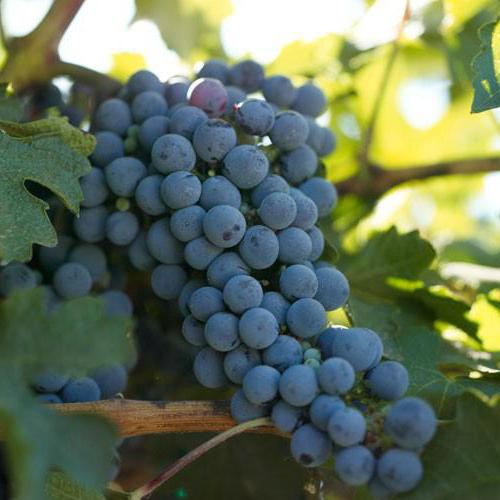

How much water do you need
Watering potatoes in the open field
For one bush of grapes, 1.5 liters of water daily is considered normal. In the absence of watering, the bunches can become shriveled and stop further development.


1.5 liters daily
It is possible to determine that the grapes do not have enough water by the absence of leaves. Spreading of grape vines over the area is also a signal of a serious lack of moisture.
When creating a schedule for watering grapes, the following factors are taken into account:
- What is the soil on the site. On sandstones, they are often watered, but in a smaller amount; black soil and clay require abundant, but rare watering;
- Weather conditions directly affect how many times and how often to water. In wet soil after recent rainfall, do not water the grapes;
- Different varieties. Late grapes are watered more abundantly and more in order to endure the winter easier;
- Parameters that include age and size. The old culture requires more abundant watering. This also includes the number of bunches, as well as the number of inflorescences. The more there are, the more watered;
- On days when it is very sunny, the plant is given more water than usual.
After a winter with little snow or a severe drought at the beginning of the growing season, in April, it is necessary to pour about 250 liters of water under the bush.
Spring watering
This filling of grapes along the trenches and the edges of the wells is carried out similarly to the autumn filling of the soil with water. It is necessary only if the winter was characterized by severe frosts and was sufficiently dry, that is, there was a small amount of precipitation in the form of snow. It is necessary to have time to water before the eyes bloom on the plants. If you water the soil with cold water, you can prevent the early appearance of eyes, which often becomes a decisive factor in the process of protecting plants from late frosts. If you need to quickly awaken the bushes for their early blooming, you should use warm water. Remember to preserve the grapes in the best possible way, which are less frequently watered in summer.


Planting watering
When planting is carried out in the fall, it is necessary to dig a planting hole of the proper size and pour about 1-2 buckets of water into it. It should be checked that the liquid is completely absorbed.As soon as it begins to remain on the surface for a long time without changing the level, watering should be stopped. Thus, the amount of water required depends on the initial moisture content of the soil. After placing the seedling, you should only half-fill the hole in winter, and then refill with about 1-2 buckets of water.
Subtleties encountered during planting watering
If you decide to plant in the spring, you will need to pour 1-2 buckets of warm water into the planting hole to warm up the soil. When the seedling is fixed in the soil, that is, the hole is filled about halfway, the soil should be saturated with an additional amount of water, amounting to about 1-2 buckets. It is advisable to insist the water in the sun, and not to heat it yourself. To increase the positive effect, it is advisable to regularly loosen the soil in the place where the grapes grow. Watering and fertilizing are very important. Especially valued means "Master", "Viva", "Kemira". They have an excellent effect on the growth and development of the plant.


Root top dressing: what and when to carry out?
In order for the green mass to actively grow, the berries were filled with juice and sugar, the vine was strong, only water was not enough, fertilizing with nitrogen, potassium and phosphorus was necessary.
When planting a seedling, a bucket of humus and 20-30 g of superphosphate are usually laid in a planting hole. These dressings for a young developing bush, actively growing the root system, are enough for 2 years of development. And additional fertilizers are needed if the rules were violated during planting.
Adult bushes actively absorb all the trace elements necessary for development from the soil, so they need to be fed with various types of fertilizers every year. Nitrogen-containing fertilizer is used for the first feeding of grapes, which is done 1 week before flowering. This element promotes the active growth of shoots and foliage.
Root feeding is carried out in trenches or drainage pits. Some growers combine watering with top dressing.
Organic or mineral fertilizers are used as nitrogen fertilization. Mullein and bird droppings have a good nitrogen content. Feeding is carried out with infusions based on the selected raw materials. On a bush of an adult plant for 10 liters of water, take 2 kg of manure or 50 g of bird droppings, mix well and watered. Mineral fertilizer is used for feeding as follows: 65 g of nitrophoska and 5 g of boric acid per bucket of water.
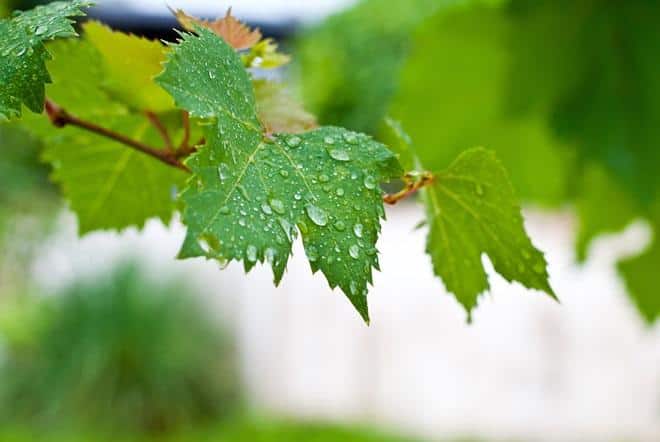

The second dressing is intended both for foliage growth and for the formation of large berries. Therefore, the main elements of fertilizing solutions are nitrogen and potassium. It is carried out 2 weeks before the formation of fruits. Top dressing is used on a grape bush: 10 g of potassium magnesia and 20 g of ammonium nitrate are dissolved in 10 liters of water. Repeat after a week.
15 days before picking the berries, the fourth feeding is carried out, which actively affects the increase in the mass of the berries and the increase in the level of sugar content. The main elements are phosphorus and potassium. For preparation, take 20 g of superphosphate and 20 g of potassium fertilizer, dissolve in a bucket of water and water.
Watering and fertilizing grapes during the growing season of the first year
If there is a question about how often to water the grapes, it should be remembered that in the first year of the plant's life you are obliged to contribute in every possible way to the development of its root system. Usually, the roots develop at a short distance first, which covers the planting hole. In order to effectively water, it is necessary to make a hole near the root itself and pour moisture in dosed doses, monitoring its optimal absorption.
To create a hole, you need to visually visualize a circle or carefully draw it on the ground. The diameter of the circle is approximately 25-30 cm. The depth is measured approximately 20-25 cm, you can also measure the hole while digging by comparing it with the bottom of the bayonet of the shovel.When the hole is dug, it can be cleaned of excess soil and poured abundantly with water. When absorption has occurred, the hole should be covered with earth and the surface should be loosened for better air circulation to the plant. It is advisable to apply fertilizers together with watering. Many gardeners recommend a 1:10 ratio of mullein tincture.
The dose of the solution should be approximately calculated: for 1 liter of water, it is 0.5 liters of solution. Also great are "Master", "Kemira", "Viva". They should be diluted according to the instructions on the package. To give the vine a better maturity, you should stop watering at the onset of August. It should be remembered that excess moisture can do more damage to the root system than lack of moisture, so you should not pour liquids above the norm.
Signs of moisture deficiency and excess
Symptoms of water shortage:
- drying of the edges of the leaves;
- the appearance of yellow spots on the leaf plates;
- discoloration of leaves (yellowing);
- straightening the crowns of the shoots;
- falling of the lower, then the upper leaves;
- drying of the tops of the shoots;
- berries become smaller, some shrivel and dry out.
What happens with excess moisture:
- violent growth of shoots;
- the formation of a large number of stepchildren;
- slow ripening of fruits;
- watery berry taste;
- roots rot at low temperatures.
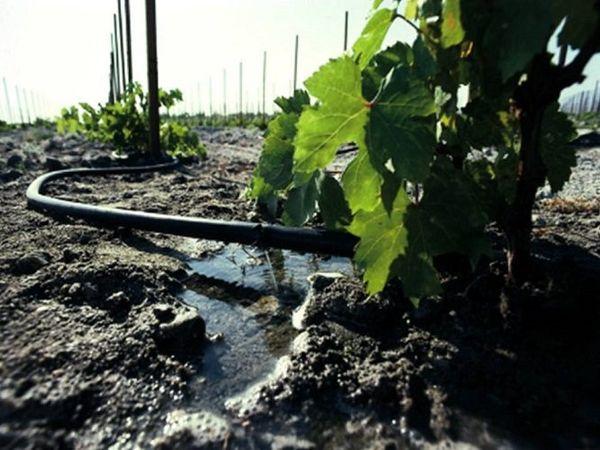

Vegetation irrigation
If the question arises as to how often to water the grapes, you need to remember that this should be done several times during the growing season. The frequency of irrigation and the amount of moisture should be determined independently by correctly assessing the condition of the plant. You should pay attention not only to the stem, but also to the leaves, their shape, size and integrity.
Usually the plant is watered in the late afternoon with water preheated under the sun's rays. Enough 5-20 liters of liquid for each bush. The exact amount of water is determined not only by the size and condition of each bush, but also by the frequency of watering that the owners of the site have the opportunity to carry out.
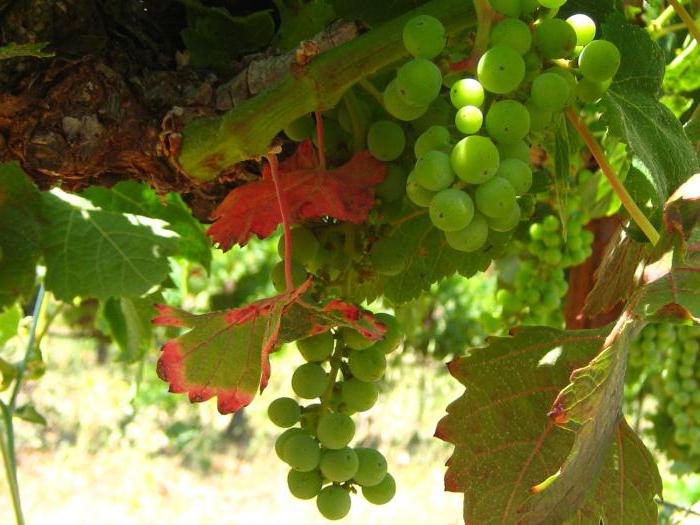

Watering grapes that have recently been planted should preferably be done about once a week with heated water. Usually, gardeners add fertilizers made from microscopic crystals to the liquid. For these purposes "Kemira combi" or "Master" is perfect. It is advisable to dilute them in a tablespoon for every 10 liters of water. You should also pay attention to foliar feeding. It is recommended to exercise them in the evening.
When a month passes after the grapes are planted, watering and fertilizing are reduced by 2 times. Usually they are carried out 2 times a month. At the onset of August, watering of the grapes is temporarily canceled, which allows you to maintain health and promotes the ripening of the vine. Watering is carried out only with warm water strictly in the holes with preliminary removal of boles. About 40-60 liters of water should be distributed per square meter of food area. Together with vegetative irrigation, it is desirable to carry out foliar dressing, since in this case the effectiveness of each method increases several times.
How to determine if there is not enough moisture
Deficiency at any time of the year is dangerous for plants. This leads to a weakening, a decrease in yield. It is quite easy to notice this in time if you carefully observe the condition of the plants. Since the roots are deep, it is important to monitor the degree of moisture not only in the surface layer.
To build the optimal regimen, a combined method is used: visual observation and tonsiometric analysis. This will maintain the optimum humidity level.
Visual
Determining whether grapes have enough liquid is possible by their appearance. Leaves have a natural green color until they fall off. Crowns on young shoots are curved. Normally, they straighten only during the ripening of the berries. If there is a shortage, the stem will fully recover only after 1 - 2 seasons.This leads to a decrease in yield, quality of berries. This material will tell you about fertilizers for grapes.
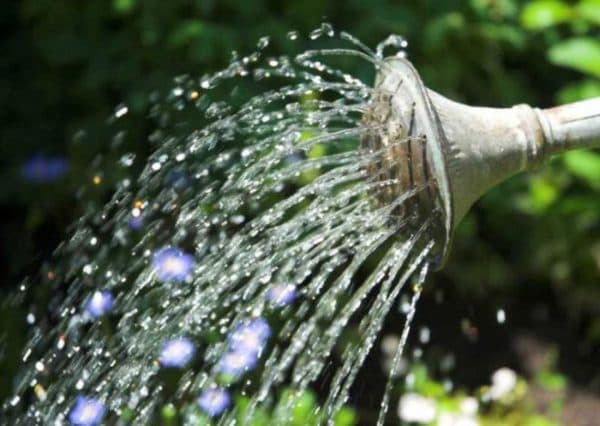

Lack of moisture leads to shrinkage of the bushes and a decrease in the size of the berries.
Tensiometric analysis
To accurately measure humidity, a special device is used - a tensiometer. It allows you to assess the level of penetration into different soil layers. It allows you to assess the level of humidity. It is established in the spring, before the start of the growing season. Take out the device in the fall, before the first frost. Can be used for measurements on sandy and sandy loam,
The tensiometer has an easy-to-use color scale, making it easy for beginners to use. At optimum humidity, the pressure gauge needle is at the green mark. Blue or light blue indicates excess. Orange to red - critical drought.


How often should the grapes be watered?
Watering through a pipe is often done, since this plant is especially sensitive and requires an increased moisture content in the soil at such times:
- The period during which the set and subsequent budding of the plant occurs.
- Time after flowering, that is, at the moment when the fruit ovary is already fully formed and is in the period of development, the plant requires a large amount of nutrients to be able to endow them with fruits. You should take care of the grapes. Watering during flowering is harmful, so you should add moisture to the soil immediately after it.
- Berry growth and filling. The abundance of watering depends not only on the size of the berries, but also on their color, as well as the benefits for all consumers.
Do not wet the grapes too much. Watering should be dosed, and not carried out immediately before the formation of flowers, as well as during the active phase of flowering. This will cause massive shedding of flowers, which means, significantly reduce the yield. Do not water the plant just before harvesting, as this will not only slow down the development of the berries, but can also lead to their cracking.
When to stop watering grape bushes in summer
How to water the grapes in August should be decided by the gardener, focusing on the main varietal characteristic of plants - the ripening time of the berries.
Excessive watering will provoke the active growth of the bushes, the plant will not have time to mature and reorganize to the phase of inhibition of development, will not begin to prepare the tissues of the vine for the winter cold.
Frequent summer watering in the southern regions is a completely justified event, without which plants may die. In Central Russia, the frequency of irrigation must be regulated depending on climatic changes, only in this case, the desired result can be obtained.


